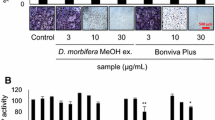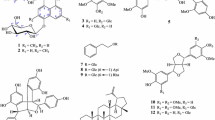Abstract
We screened natural products to find compounds with anti-osteoporotic potential using a coculture-based system by which osteoclast differentiation is effectively achieved. We found that methylene chloride soluble fraction of the root ofSalvia miltiorrhiza Bunge (Labiatae) suppressed osteoclast differentiation. Five tanshinones, tanshinone IIA (1), tanshinone I (2), cryptotanshinone (3), 15,16-dihydrotanshinone I (4), and ferruginol (5) were subsequently isolated from fraction. Among the five compounds, compounds1–4 reduced the formation of TRAP-positive multinuclear osteoclasts. These results suggest that the identified tanshinones may be useful candidates for development of therapeutic agents to treat osteoporosis and other bone-resorptive diseases.
Similar content being viewed by others
References
Anderson, D. M., Maraskovsky, E., Billingsley, W. L., Dougall, W. C., Tometsko, M. E., Roux, E. R., Teepe, M. C., DuBose, R. F., Cosman, D., and Galibert, L. A., Homologue of the TNF receptor and its ligand enhance T-cell growth and dendritic-cell function.Nature 390, 175–195 (1997).
Harrison, L. J. and Asakawa, Y., 18-Oxoferruginol from the leaf ofTorreya nucifera.Phytochemistry, 26, 1211–1212 (1987).
Lacey, D. L., Tan, H. L., Lu, J., Kaufman, S., Van, G., Qiu, W., Rattan, A., Scully, S., Fletcher, F., Juan, T., Kelley, M., Burgess, T. L., Boyle, W. J., and Polverino, A. J., Osteoprotegerin ligand modulates murine osteoclast survivalin vitro andin vivo.Am. J. Pathol., 157, 435–48 (2000).
Lee, Z. H. and Kim, H. H., Signal transduction by receptor activator of nuclear factor kappa B in osteoclasts.Biochem. Biophys. Res. Commun., 305, 211–214 (2003).
Lee, S. E., Woo, K. M., Kim, S. Y., Kim, H. M., Kwack, K., Lee, Z. H., and Kim, H. H., The phosphatidylinositol 3-kinase, p38, and extracellular signal-regulated kinase pathways are involved in osteoclast differentiation,Bone, 30, 71–77 (2002).
Lee, S. E., Chung, W. J., Kwack, H. B., Chung, C. H., Kwack, K., Lee, Z. H., and Kim, H. H., Tumor necrosis factor-α supports the survival of osteoclasts through the activation of Akt and ERKJ. Biol. Chem., 276, 49343–49349 (2001).
Miyamoto, T., Arai, F., Ohneda, O., Takagi, K., Anderson, D. M., and Suda, T., An adherent condition is required for formation of multinuclear osteoclasts in the presence of macrophage colony-stimulating factor and receptor activator of nuclear factor kappa B ligand.Blood, 96, 4335–4343 (2000).
Mundy, G., Bone remodeling, In Favus, M. J. (Eds.) Primer on the metabolic bone diseases and disorders of mineral metabolism. Lippincott Williams & Wilkins Philadelphia, pp. 30–38 (1999).
Ryu, S. Y., No, Z. S., Kim, S. H., and Ahn, J. W., Two novel abietane diterpenes fromSalvia miltorrhiza.Planta Med., 63, 44–46 (1997).
Suda, T., Takahashi, N., Udagawa, N., Jimi, E., Gillespie, M. T., and Martin, T. J., Modulation of osteoclast differentiation and function by the new members of the tumor necrosis factor receptor and ligand families.Endocr. Rev., 20, 345–357 (1999).
Takeshita, S., Kaji, K., and Kudo, A., Identification and characterization of the new osteoclast progenitor with macrophage phenotypes being able to differentiate into mature osteoclasts.J. Bone Miner. Res. 15, 1477–1488 (2000).
Tang, W. and Eisenbrand, G., Chinese drugs of plant origin, Berlin, Springer-Verlag, (1992).
Tezuka, Y., Kasimu, R., Basnet, P., Namba, T., and Kadota S., Aldose reductase inhibitory constituents of the root ofSalvia miltiorhiza BUNGE.Chem. Pharm. Bull., 45, 1306–1311 (1997).
Yasuda, H., Shima, N., Nakagawa, N., Yamaguchi, K., Kinosaki, M., Mochizuki, S. I., Tomoyasu, A., Yano, K., Goto, M., Murakami, A., Tsuda, E., Morinaga, T., Higashio, K., Udagawa, N., Takahash, N., and Suda, T., Osteoclast differentiation factor is a ligand for osteoprotegerin/osteoclastogenesis-inhibitory factor and identical to TRANCE-RANKL.Proc. Natl. Acad. Sci. U.S.A., 95, 3579–3602 (1998).
Author information
Authors and Affiliations
Corresponding author
Rights and permissions
About this article
Cite this article
Lee, SY., Choi, DY. & Woo, ER. Inhibition of osteoclast differentiation by tanshinones from the root ofSalvia miltiorrhiza Bunge. Arch Pharm Res 28, 909–913 (2005). https://doi.org/10.1007/BF02973876
Received:
Issue Date:
DOI: https://doi.org/10.1007/BF02973876




